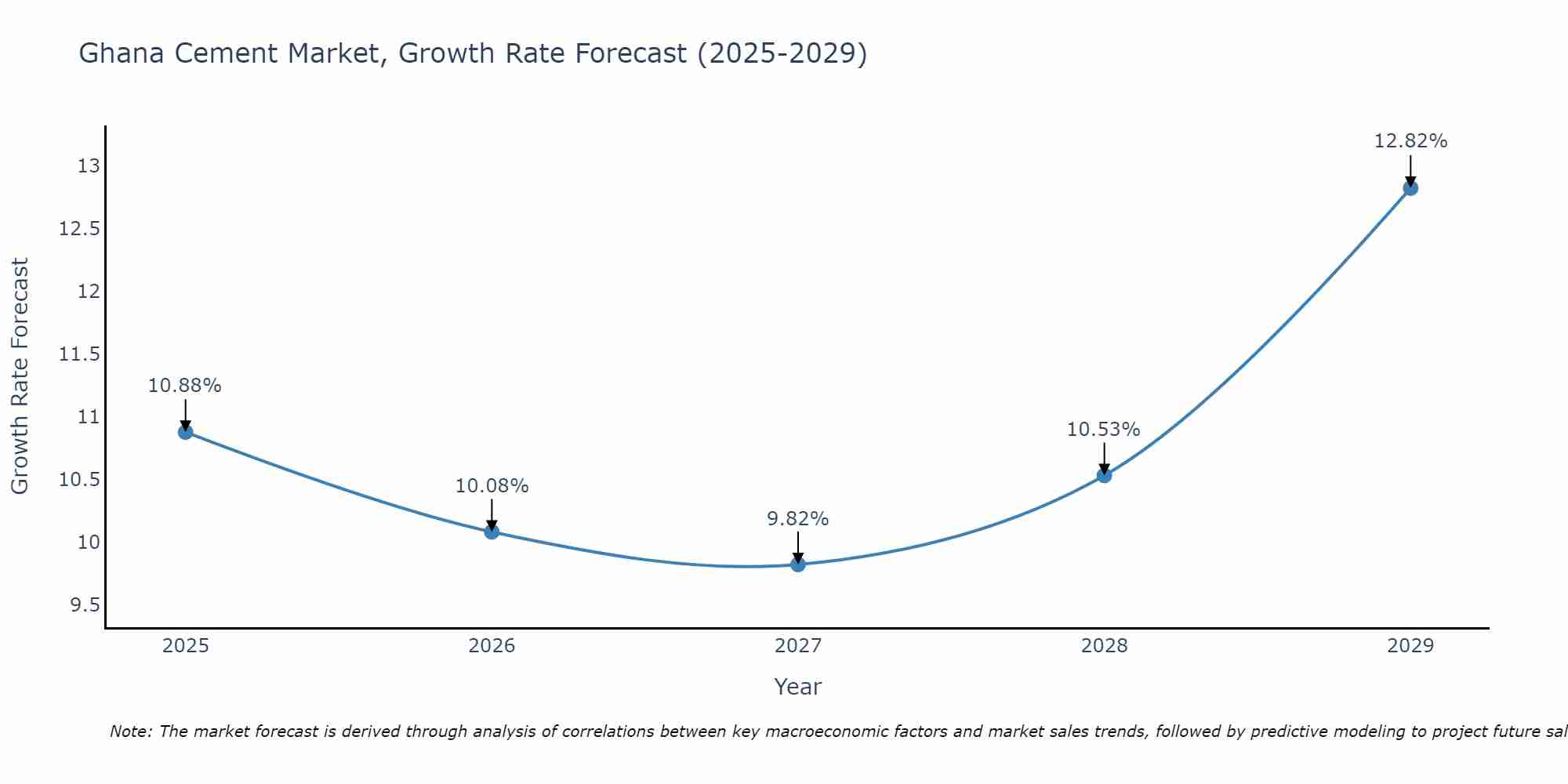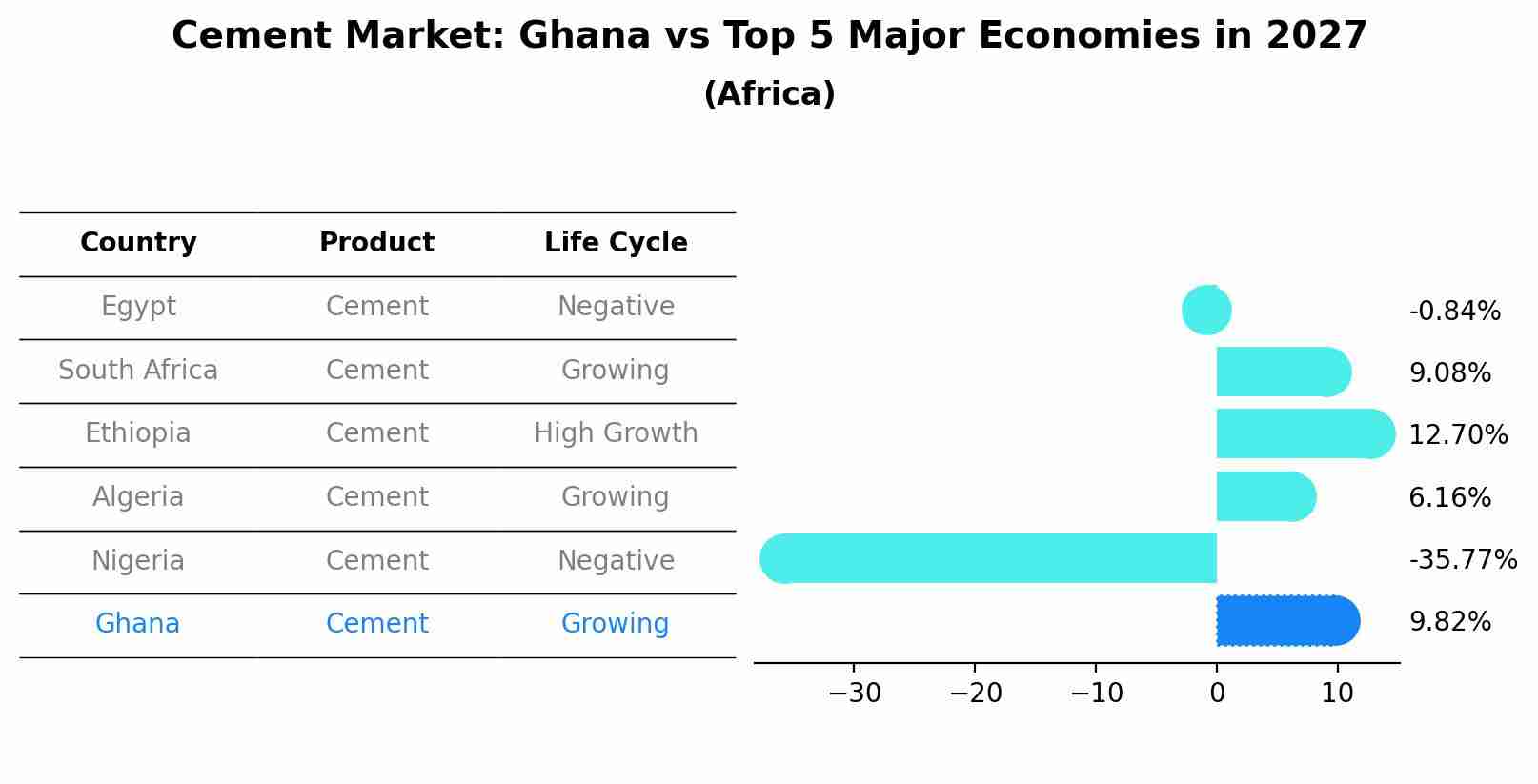Ghana Cement Market (2025-2031) | Industry, Revenue, Outlook, Value, Analysis, Trends, Share, Companies, Forecast, Size & Growth
| Product Code: ETC023296 | Publication Date: Oct 2020 | Updated Date: Jun 2025 | Product Type: Report | |
| Publisher: 6Wresearch | Author: Summon Dutta | No. of Pages: 70 | No. of Figures: 35 | No. of Tables: 5 |
Ghana Cement Market Size Growth Rate
The Ghana Cement Market is projected to witness mixed growth rate patterns during 2025 to 2029. Commencing at 10.88% in 2025, growth builds up to 12.82% by 2029.

Cement Market: Ghana vs Top 5 Major Economies in 2027 (Africa)
Ghana's Cement market is anticipated to experience a growing growth rate of 9.82% by 2027, reflecting trends observed in the largest economy Egypt, followed by South Africa, Ethiopia, Algeria and Nigeria.

Ghana Cement Market Overview
The Ghana Cement Market is characterized by a competitive landscape with major players such as Dangote Cement, Ghacem, CIMAF, and Diamond Cement. The market is driven by increasing construction activities in both residential and commercial sectors, fueled by urbanization and infrastructure development projects across the country. Government initiatives to boost the construction industry, coupled with a growing population and rising investments in real estate, are further driving the demand for cement in Ghana. However, the market faces challenges such as fluctuating prices of raw materials, infrastructure constraints, and intense competition among manufacturers. To stay competitive, companies are focusing on product innovation, quality, sustainability, and expanding distribution networks to reach a wider customer base in this dynamic market.
Ghana Cement Market Trends
The Ghana Cement Market is experiencing several key trends. One prominent trend is the growing demand for infrastructure development projects across the country, including roads, bridges, and housing construction. This is driving the demand for cement products in the market. Additionally, there is a shift towards the use of sustainable and environmentally friendly cement products, with a focus on reducing carbon emissions and promoting eco-friendly construction practices. Another trend is the increasing competition among cement manufacturers, leading to innovations in product offerings and marketing strategies to capture a larger market share. Overall, the Ghana Cement Market is dynamic and evolving, with a strong emphasis on meeting the growing construction needs of the country while also embracing sustainability and innovation.
Ghana Cement Market Challenges
In the Ghana cement market, some of the key challenges faced include intense competition among existing cement manufacturers, volatility in raw material prices such as limestone and gypsum, and the high cost of energy for production. Additionally, infrastructure constraints and logistical challenges in transporting cement to remote areas also pose obstacles for market players. Regulatory issues, such as taxes and import restrictions, can further impact the industry. Moreover, the market is sensitive to macroeconomic factors like currency fluctuations and inflation rates, which can affect consumer purchasing power and overall demand for cement products. Overall, navigating these challenges requires cement companies in Ghana to adopt strategic pricing, efficient supply chain management, and innovative marketing tactics to remain competitive in the market.
Ghana Cement Market Investment Opportunities
The Ghana cement market offers several investment opportunities due to the country`s growing construction industry and infrastructure development projects. With a stable economic environment and increasing urbanization rates, demand for cement is expected to remain strong in the coming years. Investors can consider opportunities in cement manufacturing companies operating in Ghana, as well as investing in logistics and distribution networks to ensure efficient supply chain management. Additionally, there is potential for investments in alternative construction materials and technologies that can complement the cement market, such as eco-friendly building materials or innovative construction methods. Overall, the Ghana cement market presents a promising landscape for investors looking to capitalize on the country`s construction sector growth.
Ghana Cement Market Government Policy
The Ghanaian government has implemented various policies to regulate the cement market in the country. One key policy is the Ghana Investment Promotion Center Act, which encourages foreign investment in the cement industry through incentives and support. Additionally, the government has imposed tariffs on imported cement to protect local manufacturers and promote self-sufficiency. The Ghana Standards Authority also plays a crucial role in ensuring the quality of cement products through certification and monitoring. Moreover, the government has introduced initiatives to promote affordable housing, which drives the demand for cement in the construction sector. Overall, these policies aim to foster a competitive and sustainable cement market in Ghana while supporting economic growth and development.
Ghana Cement Market Future Outlook
The Ghana Cement Market is poised for steady growth in the coming years, driven by increasing construction activities, infrastructure development projects, and urbanization trends in the country. The government`s focus on improving the country`s infrastructure, such as roads, bridges, and affordable housing initiatives, will drive demand for cement. Additionally, the growing population and rising middle-class segment are expected to boost the construction sector, further fueling the demand for cement. With several cement manufacturers operating in the market and investing in capacity expansions and product innovations, the industry is set to experience healthy competition and technological advancements, leading to a dynamic and evolving market landscape in Ghana. Overall, the future outlook for the Ghana Cement Market appears promising, with opportunities for growth and development on the horizon.
Key Highlights of the Report:
- Ghana Cement Market Outlook
- Market Size of Ghana Cement Market, 2024
- Forecast of Ghana Cement Market, 2026
- Historical Data and Forecast of Ghana Cement Revenues & Volume for the Period 2021 - 2031
- Ghana Cement Market Trend Evolution
- Ghana Cement Market Drivers and Challenges
- Ghana Cement Price Trends
- Ghana Cement Porter's Five Forces
- Ghana Cement Industry Life Cycle
- Historical Data and Forecast of Ghana Cement Market Revenues & Volume By Product for the Period 2021 - 2031
- Historical Data and Forecast of Ghana Cement Market Revenues & Volume By Portland for the Period 2021 - 2031
- Historical Data and Forecast of Ghana Cement Market Revenues & Volume By Others for the Period 2021 - 2031
- Historical Data and Forecast of Ghana Cement Market Revenues & Volume By Application for the Period 2021 - 2031
- Historical Data and Forecast of Ghana Cement Market Revenues & Volume By Residential for the Period 2021 - 2031
- Historical Data and Forecast of Ghana Cement Market Revenues & Volume By Non-residential/Infrastructure for the Period 2021 - 2031
- Ghana Cement Import Export Trade Statistics
- Market Opportunity Assessment By Product
- Market Opportunity Assessment By Application
- Ghana Cement Top Companies Market Share
- Ghana Cement Competitive Benchmarking By Technical and Operational Parameters
- Ghana Cement Company Profiles
- Ghana Cement Key Strategic Recommendations
Frequently Asked Questions About the Market Study (FAQs):
1 Executive Summary |
2 Introduction |
2.1 Key Highlights of the Report |
2.2 Report Description |
2.3 Market Scope & Segmentation |
2.4 Research Methodology |
2.5 Assumptions |
3 Ghana Cement Market Overview |
3.1 Ghana Country Macro Economic Indicators |
3.2 Ghana Cement Market Revenues & Volume, 2019 & 2026F |
3.3 Ghana Cement Market - Industry Life Cycle |
3.4 Ghana Cement Market - Porter's Five Forces |
3.5 Ghana Cement Market Revenues & Volume Share, By Product , 2019 & 2026F |
3.6 Ghana Cement Market Revenues & Volume Share, By Application , 2019 & 2026F |
4 Ghana Cement Market Dynamics |
4.1 Impact Analysis |
4.2 Market Drivers |
4.3 Market Restraints |
5 Ghana Cement Market Trends |
6 Ghana Cement Market, By Types |
6.1 Ghana Cement Market, By Product |
6.1.1 Overview and Analysis |
6.1.2 Ghana Cement Market Revenues & Volume, By Product , 2016 - 2026F |
6.1.3 Ghana Cement Market Revenues & Volume, By Portland, 2016 - 2026F |
6.1.4 Ghana Cement Market Revenues & Volume, By Others, 2016 - 2026F |
6.2 Ghana Cement Market, By Application |
6.2.1 Overview and Analysis |
6.2.2 Ghana Cement Market Revenues & Volume, By Residential, 2016 - 2026F |
6.2.3 Ghana Cement Market Revenues & Volume, By Non-residential/Infrastructure, 2016 - 2026F |
7 Ghana Cement Market Import-Export Trade Statistics |
7.1 Ghana Cement Market Export to Major Countries |
7.2 Ghana Cement Market Imports from Major Countries |
8 Ghana Cement Market Key Performance Indicators |
9 Ghana Cement Market - Opportunity Assessment |
9.1 Ghana Cement Market Opportunity Assessment, By Product , 2019 & 2026F |
9.2 Ghana Cement Market Opportunity Assessment, By Application , 2019 & 2026F |
10 Ghana Cement Market - Competitive Landscape |
10.1 Ghana Cement Market Revenue Share, By Companies, 2024 |
10.2 Ghana Cement Market Competitive Benchmarking, By Operating and Technical Parameters |
11 Company Profiles |
12 Recommendations |
13 Disclaimer |
- Single User License$ 1,995
- Department License$ 2,400
- Site License$ 3,120
- Global License$ 3,795
Search
Thought Leadership and Analyst Meet
Our Clients
Related Reports
- Australia Briquette Market (2025-2031) | Growth, Size, Revenue, Forecast, Analysis, Trends, Value, Share, Industry & Companies
- Vietnam System Integrator Market (2025-2031) | Size, Companies, Analysis, Industry, Value, Forecast, Growth, Trends, Revenue & Share
- ASEAN and Thailand Brain Health Supplements Market (2025-2031) | Strategy, Consumer Insights, Analysis, Investment Trends, Opportunities, Growth, Size, Share, Industry, Revenue, Segments, Value, Segmentation, Supply, Forecast, Restraints, Outlook, Competition, Drivers, Trends, Demand, Pricing Analysis, Competitive, Strategic Insights, Companies, Challenges
- ASEAN Bearings Market (2025-2031) | Strategy, Consumer Insights, Analysis, Investment Trends, Opportunities, Growth, Size, Share, Industry, Revenue, Segments, Value, Segmentation, Supply, Forecast, Restraints, Outlook, Competition, Drivers, Trends, Demand, Pricing Analysis, Competitive, Strategic Insights, Companies, Challenges
- Europe Flooring Market (2025-2031) | Outlook, Share, Industry, Trends, Forecast, Companies, Revenue, Size, Analysis, Growth & Value
- Saudi Arabia Manlift Market (2025-2031) | Outlook, Size, Growth, Trends, Companies, Industry, Revenue, Value, Share, Forecast & Analysis
- Uganda Excavator, Crane, and Wheel Loaders Market (2025-2031) | Strategy, Consumer Insights, Analysis, Investment Trends, Opportunities, Growth, Size, Share, Industry, Revenue, Segments, Value, Segmentation, Supply, Forecast, Restraints, Outlook, Competition, Drivers, Trends, Demand, Pricing Analysis, Competitive, Strategic Insights, Companies, Challenges
- Rwanda Excavator, Crane, and Wheel Loaders Market (2025-2031) | Strategy, Consumer Insights, Analysis, Investment Trends, Opportunities, Growth, Size, Share, Industry, Revenue, Segments, Value, Segmentation, Supply, Forecast, Restraints, Outlook, Competition, Drivers, Trends, Demand, Pricing Analysis, Competitive, Strategic Insights, Companies, Challenges
- Kenya Excavator, Crane, and Wheel Loaders Market (2025-2031) | Strategy, Consumer Insights, Analysis, Investment Trends, Opportunities, Growth, Size, Share, Industry, Revenue, Segments, Value, Segmentation, Supply, Forecast, Restraints, Outlook, Competition, Drivers, Trends, Demand, Pricing Analysis, Competitive, Strategic Insights, Companies, Challenges
- Angola Excavator, Crane, and Wheel Loaders Market (2025-2031) | Strategy, Consumer Insights, Analysis, Investment Trends, Opportunities, Growth, Size, Share, Industry, Revenue, Segments, Value, Segmentation, Supply, Forecast, Restraints, Outlook, Competition, Drivers, Trends, Demand, Pricing Analysis, Competitive, Strategic Insights, Companies, Challenges
Industry Events and Analyst Meet
Whitepaper
- Middle East & Africa Commercial Security Market Click here to view more.
- Middle East & Africa Fire Safety Systems & Equipment Market Click here to view more.
- GCC Drone Market Click here to view more.
- Middle East Lighting Fixture Market Click here to view more.
- GCC Physical & Perimeter Security Market Click here to view more.
6WResearch In News
- Doha a strategic location for EV manufacturing hub: IPA Qatar
- Demand for luxury TVs surging in the GCC, says Samsung
- Empowering Growth: The Thriving Journey of Bangladesh’s Cable Industry
- Demand for luxury TVs surging in the GCC, says Samsung
- Video call with a traditional healer? Once unthinkable, it’s now common in South Africa
- Intelligent Buildings To Smooth GCC’s Path To Net Zero


















